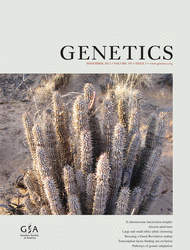-
PDF
- Split View
-
Views
-
Cite
Cite
ISSUE HIGHLIGHTS, Genetics, Volume 192, Issue 3, 1 November 2012, Page NP, https://doi.org/10.1093/genetics/192.3.NP
Close - Share Icon Share
An ex vivo model for imprinting: Mutually exclusive binding of Cdx2 and Oct4 as a switch for imprinted and random X-inactivation, pp. 857–868
Jennifer A. Erwin, Brian del Rosario, Bernhard Payer, and Jeannie T. Lee
X chromosome inactivation (XCI) is initially seen only on the parental X chromosome during embryogenesis. This imprinted XCI later becomes random, occurring on either the maternal or paternal X. This article describes a cell culture model for imprinting, discovery of a protein required for imprinted XCI, and the roles of two transcription factors in the switch between imprinted and random XCI in the early mouse embryo.
Small- and large-effect quantitative trait locus interactions underlie variation in yeast sporulation efficiency, pp. 1123–1132
Kim Lorenz and Barak A. Cohen
Sporulation efficiency in yeast is a complex trait controlled by alleles of both large and small effect. These investigators report that smalleffect alleles differ depending on which large-effect alleles are present in the background, suggesting there are strong interactions between large- and small-effect alleles. Curiously, each large-effect allele had a nearby small effect allele, suggesting that variable alleles for a trait may cluster together in the genome.
Ancient admixture in human history, pp. 1065–1093
Nick Patterson, Priya Moorjani, Yontao Luo, Swapan Mallick, Nadin Rohland, Yiping Zhan, Teri Genschoreck, Teresa Webster, and David Reich
This article presents a suite of methods for learning about the history of genetic population mixtures. Application of the methods yielded the striking finding of a clear signal of admixture into northern Europe that likely reflects a history of admixture between Neolithic migrants and the indigenous Mesolithic population of Europe, consistent with recent analyses of ancient bones from Sweden and the genome sequence of the Tyrolean “Iceman”.
Elucidating molecular networks that either affect or respond to plasma cortisol concentration in target tissues of liver and muscle, pp. 1109–1122
Siriluck Ponsuksili, Yang Du, Eduard Murani, Manfred Schwerin, and Klaus Wimmers
Cortisol has physiological implications for neurobiological, immune, and metabolic processes. This study addresses the genetics of variation in cortisol concentrations by integrating global gene expression and genome-wide association analyses of the level of expression quantitative trait loci detection with causality modeling. The study revealed genes that affect or respond to cortisol levels that are thus of interest in stress biology and animal breeding.
Pathways of genetic adaptation: Multistep origin of mutants under selection without induced mutagenesis in Salmonella enterica, pp. 987–999
Semarhy Quiñones-Soto, Andrew B. Reams, and John R. Roth
Bacterial populations plated on growth-limiting medium give rise to well-adapted mutant colonies that accumulate above a lawn of nongrowing cells. This has been attributed to stress-induced mutagenesis of nongrowing cells, but this article presents evidence that this behavior can result from pre-existing small-effect mutations that enable growth and adaptation under selection, with no change in mutation rate.
Why transcription factor binding sites are ten nucleotides long, pp. 973–985
Alexander J. Stewart, Sridhar Hannenhalli, and Joshua B. Plotkin
From bacteria to humans, transcription factor binding sites are roughly ten nucleotides long. This article shows how natural selection can explain this general feature of gene regulation. When the length and information content of binding sites are allowed to evolve, in a population-genetic model, they become constrained in an evolutionarily stable region. The predicted region coincides with the range of binding site lengths observed in nature.
Nonrandom X chromosome inactivation is influenced by multiple regions on the murine X chromosome, pp. 1095–1107
Joanne L. Thorvaldsen, Christopher Krapp, Huntington F. Willard, and Marisa S. Bartolomei
The X chromosome controlling element (Xce) that causes nonrandom X chromosome inactivation in F1 hybrid mice was described more than 40 years ago. This article describes genetic studies that reveal multiple elements on the X chromosome that contribute to Xce activity. This genetic approach uncovers candidate Xce regions that were not exposed by conventional mutational analyses.
High-throughput discovery of mutations in tef semi-dwarfing genes by next-generation sequencing analysis, pp. 819–829
Qihui Zhu, Shavannor M. Smith, Mulu Ayele, Lixing Yang, Ansuya Jogi, Srinivasa R. Chaluvadi, and Jeffrey L. Bennetzen
Because orphan crops did not participate in the Green Revolution, no semi-dwarf varieties are available to ameliorate lodging of crops such as tef (Eragrostis tef), a major cereal crop in Ethiopia. Recessive mutations like those responsible for semi-dwarf varieties of rice, sorghum, and pearl millet are difficult to obtain in this allotetraploid species. These investigators used next-generation DNA sequencing to identify mutations in two homeologous dwarfing genes, providing germplasm with the potential to increase tef productivity.
This Month's Perspectives
Genome evolution due to allopolyploidization in wheat, pp. 763–774
Moshe Feldman and Avraham A. Levy
Polyploidization in plants has been most thoroughly studied in wheat species. In this article, evidence is reviewed showing that allopolyploidization accelerates genome evolution by: 1) promoting rapid genome alterations through the instantaneous generation of many genetic and epigenetic changes and; 2) facilitating longer-term sporadic genomic changes, not attainable at the diploid level, throughout the species’ evolution. The latter alterations lead to the diploidization of the allopolyploids. The broader evolutionary significance of the findings is discussed.
This Month in the American Journal of Human Genetics
AZFc Deletions and Spermatogenic Failure: A Population-Based Survey of 20,000 Y Chromosomes. Am. J. Hum. Genet. 92(1)
Steven G. Rozen, Janet D. Marszalek, Kathryn Irenze, Helen Skalet sky, Laura G. Brown, Robert D. Oates, Sherman J. Silber, Kristin Ardlie, and David C. Page
The most common cause of severe spermatogenic (SSF) failure, which affects nearly two percent of all men, are deletions involving the AZFc region of the Y chromosome. Rozen et al. assess the prevalence of six recurrent AZFc deletions across five populations and find that a rare and a common variant account for the largest proportion of SSF. This information will assist clinicians, and is also bound to attract attention of population geneticists.



